Part 1: About us
Our purpose
The Controller and Auditor-General (the Auditor-General) carries out audits, performance audits, and inquiries, and reports to Parliament and the public to improve the performance of, and the public's trust in, the public sector.
The Auditor-General's role
The Auditor-General is an Officer of Parliament who carries out her role independent of executive government and Parliament, but is accountable to Parliament for the public resources she uses to do the job.
By law, the Auditor-General is the auditor of all public entities in New Zealand – a total of almost 4000 public entities, such as government departments, central agencies, Crown entities, schools, and State-owned enterprises.
All public entities are accountable for their use of public resources and powers. It is the Auditor-General's job to give Parliament and the public independent assurance about how public entities are operating and accounting for their performance.
The role also includes auditing local authorities, which are accountable to the public for the activities they fund with locally raised revenue. As well as annual audits, the Auditor-General audits local authorities' long-term plans, which are prepared every three years.
The organisation
The work of the Auditor-General is carried out by about 350 staff in two business units – the Office of the Auditor-General (OAG) and Audit New Zealand, supported by a shared team of corporate services staff – and by auditors contracted from about 50 private sector accounting firms.
The OAG carries out strategic planning, sets policy and standards, appoints auditors and oversees their performance, carries out performance audits, provides reports and advice to Parliament, and carries out inquiries and other special studies.
Audit New Zealand is the larger of the two business units. It carries out annual audits allocated by the Auditor-General and operates from seven locations around the country. It also provides other assurance services to public entities within the Auditor-General's mandate and in keeping with the Auditor-General's auditing standard on the independence of auditors.
Figure 1 shows how all these parts fit together in our operating model.
Figure 1
Our operating model
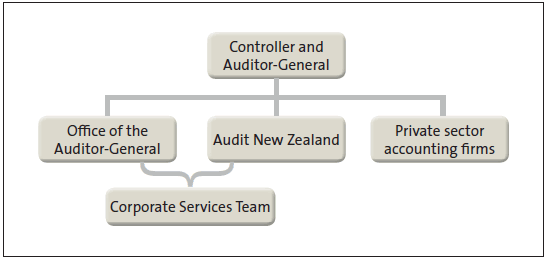
Our outcomes framework diagram in Figure 2 summarises the outcomes we are seeking, the impacts we aim to make, and the outputs we deliver. It also shows that our work is underpinned by our organisational health and capability, which is achieved through a well-run OAG and Audit New Zealand.
Our assessment of achieving our outcomes
Our overall assessment is that our outcomes were maintained or improved with:
- New Zealand maintaining its ranking in or above the 90th percentile of the Worldwide Governance Indicators in 2011;
- New Zealand's 2011 Transparency International Corruption Perceptions Index score being 9.5 out of 10, which ranked New Zealand first in the world; and
- Maintained or improved results being shown in other measures as set out in the following pages.
Figure 2
Outcomes framework
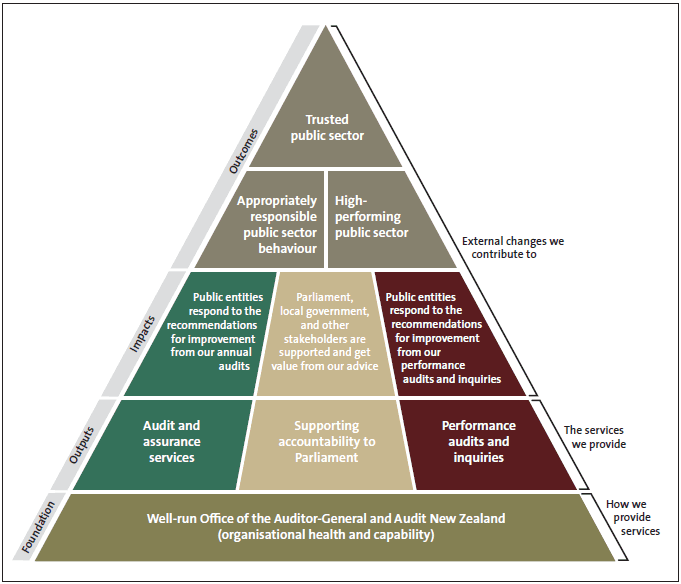

Outcome: Trusted public sector
| Measure: | New Zealand is ranked in or above the 90th percentile of the Worldwide Governance Indicators. |
|---|---|
| Result: | Achieved. New Zealand maintained its ranking in 2011, with all Worldwide Governance Indicators above the 90th percentile. |
Figure 3
New Zealand's ranking in the Worldwide Governance Indicators, 2008 to 2011
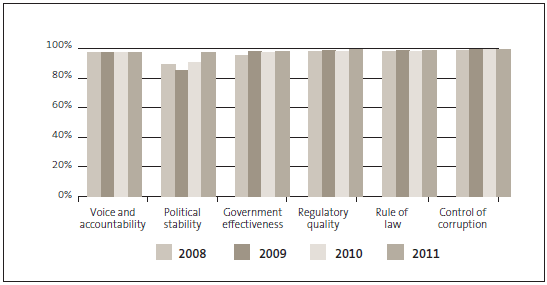
| Measure: | The State Services Commission's biannual Kiwis Count Survey* shows that the public's confidence that public servants do a good job is improved (or at least maintained). |
| Result: | Achieved. The most recent results available (2010) showed that the public's confidence that public servants do a good job has improved. |
* Changes to Kiwis Count Survey methodology mean that 2012 results for this measure are not yet available.
Figure 4
Kiwis Count Survey results in 2008 and 2010: Public servants do a good job
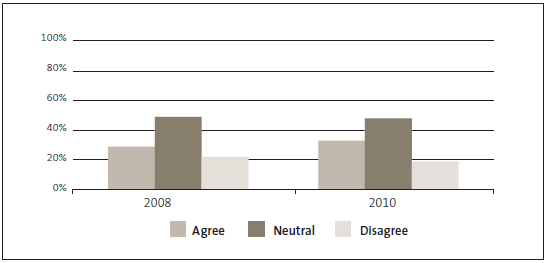
| Measure: | New Zealand's score on the Transparency International Corruption Perceptions Index is improved (or at least maintained). |
| Result: | Achieved. New Zealand's Transparency International Corruption Perceptions Index score was maintained in 2011. |
Figure 5
New Zealand's score on the Transparency International Corruption Perceptions Index, 2008 to 2011
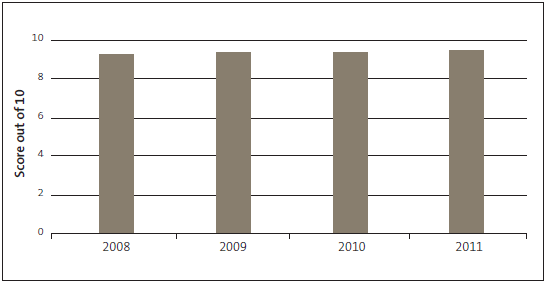
Outcome: Appropriately responsible public sector behaviour
| Measure: | Public entities' financial reports fairly reflect their actual performance and are publicly available on time. |
| Comment: | Responsible public entities provide public audited financial reports that are on time and fairly reflect their performance. Audits that are completed on time provide an indicator that public entities are well managed and meeting their reporting responsibilities. An unmodified audit opinion is an indicator that public entities are reporting appropriately and in accordance with standards. |
| Result: | Achieved. 2011/12 results showed 98% of audit opinions were unmodified and 88% of audits were completed on time (percentages are rounded to nearest whole number). |
Figure 6
Percentage of unmodified audit opinions and audits completed on time
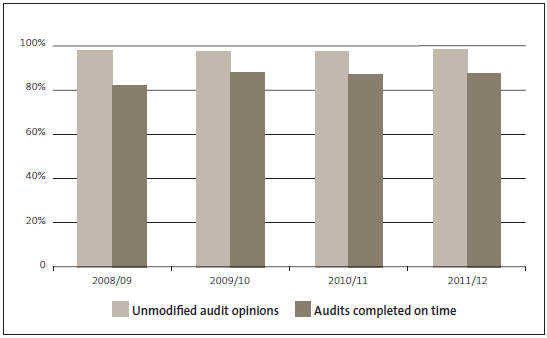
| Measure: | The State Services Commission's Integrity and Conduct Survey* shows improved (or at least maintained) rates of State servants who reported that State service agencies promote their standards of integrity and conduct. |
| Result: | Achieved. The most recent results available (2010) show improved rates of State servants who reported that State service agencies promote their standards of integrity and conduct. |
*This survey is held every three years, and results are published in calendar years.
Figure 7
Integrity and Conduct Survey results in 2007 and 2010: State service agencies that promote their standards of integrity and conduct
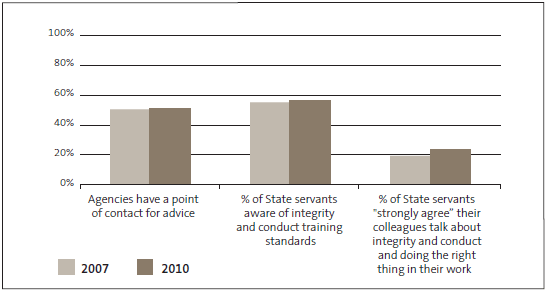
| Measure: | The State Services Commission's Integrity and Conduct Survey shows improved (or at least maintained) rates of State servants who reported that, where they observed misconduct breaches in the past year, they reported it. |
| Result: | Achieved. The most recent results available (2010) show improved rates of State servants who reported that, where they observed misconduct breaches in the past year, they reported it. |
Figure 8
Integrity and Conduct Survey results in 2007 and 2010: State servants' observation and reporting of misconduct
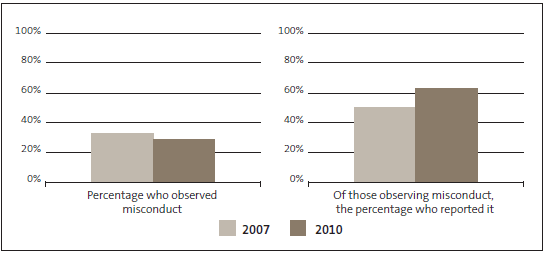
Outcome: High-performing public sector
| Measure: | The State Services Commission's biannual Kiwis Count Survey shows improved (or at least maintained) rates of public satisfaction with:
|
| Results: | Methodology changes in the Kiwis Count Survey between 2008 and 2012 mean that the results are not directly comparable. However, August 2012 results confirmed that the overall quality of service delivery had improved since 2009 with 27 services out of 42 improving, and 12 of those services showing significant improvements. No data was available on respondents' ratings of experiences with public services with non-government agencies. |
| Measure: | The State Services Commission's biannual Kiwis Count Survey shows improved (or at least maintained) rates of respondents reporting that their most recent public service experience was an example of good value for tax dollars spent. |
| Result: | Achieved. The most recent results available (2010) show improved rates of respondents reporting that their most recent public service experience was an example of good value for tax dollars spent. |
Figure 9
Kiwis Count Survey results in 2008 and 2010: Most recent public service experience was an example of good value for tax dollars spent
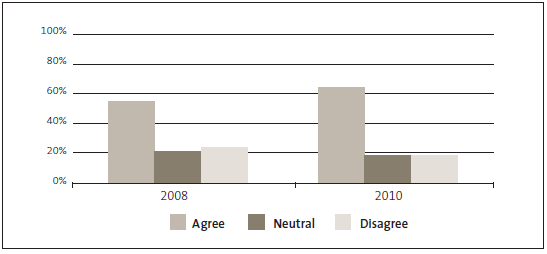
Strategic risks and risk management
The Auditor-General faces four ongoing strategic risks. These risks are primarily managed through processes that support the work we do, as shown in Figure 10.
Throughout the 2011/12 year, the Office continued its focus on managing risks, particularly strategic risks. The leadership team discusses these quarterly, including assessing any environmental or internal changes that may affect the Office's position. The Audit and Risk Committee receives a report quarterly and provides additional insight and advice to the Office regarding the strategic risks. The Committee's own report for 2011/12 is on pages 21-22.
Figure 10
Our strategic risks and risk management
| Risk | Management |
|---|---|
| 1. Loss of independence – independence underpins the value of the Auditor-General's work and reporting. Losing that independence in fact or appearance, whether by failure on the part of the Auditor-General, her staff, or her appointed auditors to act independently or otherwise, would undermine trust in our organisation. | We manage this risk by applying the Auditor-General's independence standards. The Auditor-General sets a high standard for independence for her employees and the auditors she appoints to carry out audits on her behalf. Monitoring the independence standards, including for the two statutory officers and all employees, is carried out through a system that includes regular declarations of interest and, where necessary, implementing measures to mitigate conflicts of interest. Senior managers in the Office monitor and regularly assess any factors that may threaten auditor independence. We are satisfied that the Office has appropriate plans to reduce the effect of these factors to an acceptable level. |
| 2. Audit failure – the risk that we issue an incorrect audit opinion with material effect or a report that is significantly wrong in nature or process. | The Auditor-General adheres to professional auditing standards, including implementing and complying with the revised quality control standards from the New Zealand Institute of Chartered Accountants and the External Reporting Board, supplemented by the Auditor-General's auditing standards to address public sector matters not covered by general auditing standards. We monitor adherence to auditing standards through external quality assurance regimes (such as participating in New Zealand Institute of Chartered Accountants' practice reviews and, from time to time, international peer reviews). Our internal quality control procedures include carrying out quality assurance reviews of all our appointed auditors and our Office products on a risk basis and to ensure reviews of all auditors and products over a three-year period. Before performance audits are presented to Parliament, a process of external report clearance and internal substantiation and review is observed. |
| 3. Loss of capability – the risk that we are unable to retain, recruit, or access people with the technical and other skills our audit work requires. | We carry out ongoing training and development of our staff and our appointed auditors and their staff on matters necessary for audit work. We provide management programmes, leadership development initiatives, and professional development programmes for our own staff. |
| 4. Loss of reputation – the risk that we lose reputation or credibility that affects our ability to maintain effective relationships with stakeholders. This could arise either because of failings in one of the three risk areas listed above or because of external expectations and perceptions about the role of the Office or its findings on any particular matter that has been the subject of audit scrutiny. The Auditor-General's discretionary mandate is broad, and it is inevitable that we will not meet all expectations. | Managing this risk requires the exercise of judgement about where to focus our audit effort and how best to report while also achieving the greatest likelihood of public sector improvement. There are a number of ways this risk is managed in our day-to-day work:
|
Report of the Audit and Risk Committee
for the year to 30 June 2012
Members:
| John Hagen MBA, MCom, FCA, Investigating accountant, Chairman (to 23 March 2012) Fred Hutchings BBS, FCA, Director, Chairman (from 20 June 2012) Kerry Prendergast MBA, NZRN, NZRM, CNZM, Director Phillippa Smith BA, LLB, MPP, Deputy Controller and Auditor-General Neil Walter MA, CNZM, Director (to December 2011) |
The Audit and Risk Committee is an independent committee established by and reporting directly to the Auditor-General. The Committee was established in 2003 to oversee:
- risk management and internal control;
- audit functions (internal and external) for the Office;
- financial and other external reporting;
- the governance framework and processes; and
- compliance with legislation, policies and procedures.
The Committee has no management functions.
During the past year, the Committee:
- met on three occasions to fulfil its duties and responsibilities;
- received briefings from the Auditor-General and other senior managers on key business activities of the Office, as a basis for ensuring that risks facing the Office are being appropriately addressed;
- oversaw the Office's continuing review of its risk management framework and the procedures underpinning the framework;
- discussed with the external auditors their findings from their audit work;
- monitored the implementation of recommendations made by the external auditor;
- oversaw the internal auditor's development and implementation of an audit programme;
- received and considered the report on the internal audit of the payroll system; and
- reviewed the annual report and annual financial statements of the Office prior to their approval by the Auditor-General, having particular regard to the accounting policies adopted, major judgemental areas, and compliance with legislation and relevant standards.
The Committee has reported to the Auditor-General on the above and other matters it has seen fit to do so. There are no outstanding or unresolved concerns that the Committee has brought to the attention of the Auditor-General.
Fred Hutchings
Chairman
Audit and Risk Committee
14 September 2012
page top
